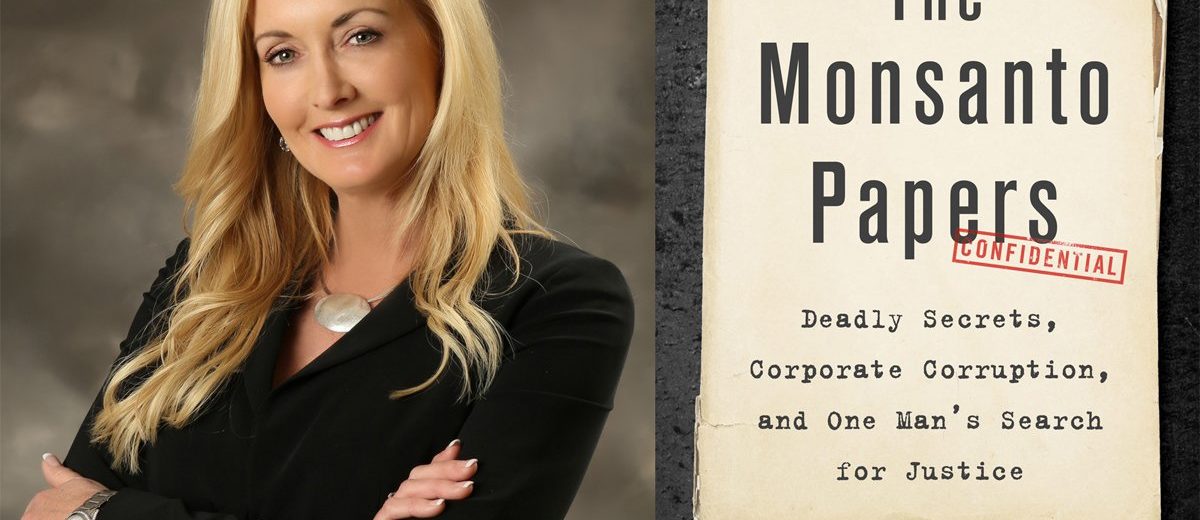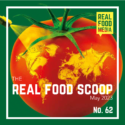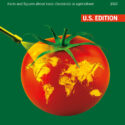by Anna Lappé, Civil Eats
In August, 2018, a judge for the Superior Court of San Francisco, California read the verdict in a first-of-its-kind case: A suit against agrochemical giant Bayer over the link between non-Hodgkin’s lymphoma and the company’s glyphosate-based weedkillers, Roundup and RangerPro. On every count, the jury found Monsanto (now owned by Bayer) guilty. The court held that Bayer’s glyphosate-based weedkiller had caused the plaintiff’s cancer to develop, the company should have warned users of the health risks and failed to do so, and it had acted with “malice, oppression, and fraud” and should pay punitive damages. The total jury award: $289.2 million—reduced to $20.5 million on appeal. (Bayer will not appeal that $20.5 million Roundup verdict—the first Roundup verdict in the nation—to the U.S. Supreme Court, the company recently announced.)
Veteran journalist and research director at public health advocacy group U.S. Right to Know Carey Gillam’s new book The Monsanto Papers offers an inside look at the legal fight that led to that historic verdict and an intimate portrait of the plaintiff at the heart of it, Lee Johnson. For the book, a follow-up to her first, Whitewash: The Story of a Weed Killer, Cancer, and the Corruption of Science, Gillam pored over 80,000 pages of exhibits and documents and a 50,000-page trial transcript to reveal a chilling story of decades of doubt, denialism, and deflection that allowed glyphosate to become the most widely used herbicide in the world. It also profiles the legal advocates trying to hold the company accountable in the absence of government regulations doing so.
I spoke with Gillam about the implications of her research, the future of glyphosate, and how Bayer plans to keep selling the controversial product.
Tell us about the herbicide at the center of this story.
Glyphosate is the active ingredient in these weed killers. Most people are familiar with Roundup as the brand name, a popular product to kill weeds in yards and gardens. Farmers use Roundup products to kill weeds in their fields and school districts and municipalities use it for a variety of reasons. It has become so ubiquitous that our government scientists have found glyphosate residues in rainfall. It’s commonly found as residues in the food we eat; it’s in the water we drink. So what the science tells us that it can do to our health and to our environment is a critically important issue.
At the heart of your story is Lee Johnson, the first plaintiff to sue Bayer, which bought Monsanto and thus took on its glyphosate liability in 2018. What’s Lee’s connection to the weedkiller?
Lee was a groundskeeper for a school district in Northern California. Part of his job was spraying these glyphosate-based weed killers around school grounds. He tried to wear protective gear as you’re supposed to do, but had been led to believe these products were safe. When he had an accident, and was doused in the weed killer, he didn’t worry about it too much because he had heard that these weedkillers were safe enough to drink. But soon after his accident, he developed a type of non-Hodgkin lymphoma. It manifests in the skin and ravages a person from head to toe. It caused Lee immense suffering and led to a terminal diagnosis. My story follows Lee from before his cancer through that journey and, ultimately, to when he decided a way to make his suffering meaningful was to try to hold Monsanto accountable and to take the company to trial.
In the book, you dive into internal Monsanto documents to tell the story of the tactics that the company used to shape the story of glyphosate. Can you describe those tactics?
The foundation to this story is that for 40 years the company has been deceiving consumers, regulators, lawmakers, farmers, and people like Lee who use glyphosate. Monsanto has been actively working to manipulate the scientific record about the safety of this chemical. That was made very clear through thousands of pages of documents, many that I had obtained before the litigation and that became the source material for my first book, Whitewash, and then the thousands of pages that came out during litigation.
There are so many examples. In these documents, Monsanto discusses ghost writing scientific papers to promote the safety of glyphosate. They also talk about funding front groups, using third-party organizations to both promote the safety of this chemical and lobby lawmakers and regulators, and to attack people like myself, scientists, or anyone pointing to evidence that indicated health problems with this chemical. They spent literally millions of dollars on these subversive campaigns to discredit legitimate, independent science and to promote their ghost-written, manipulated science. They did this over decades and you see that very clearly laid out in the documents.
The magnitude of this story was hard to wrap my mind around.
Yes, there have been so many victims: Lee Johnson was the first person to take Monsanto to trial, but now, in the United States, there are over 100,000 people who have sued Monsanto, alleging their non-Hodgkin lymphoma is caused by their exposure to Roundup.
Can you explain why the use of Roundup has increased and how it is tied to genetically engineered seeds?
Yes, genetically engineered crops, or GMOs, are linked very closely to glyphosate. Monsanto brought to market the very first genetically engineered crops in the 1990s. They weren’t designed to be more nutritious or grow better with less water; they were designed to be glyphosate-tolerant, so they could be sprayed directly with the herbicide and not die.
Why did the company focus on engineering this trait? We see from their internal records that Monsanto’s patent on glyphosate was expiring in 2000 and the company wanted to hold onto market share. They wanted to make sure generic glyphosate products didn’t take over the market. It was quite ingenious. They could develop what they called Roundup-Ready seeds and sell those to farmers as a package deal: you plant your Roundup-Ready corn, soy, cotton, canola, or sugar beets and spray directly with Roundup herbicide. The weeds in your fields will die and your crops will not.
Farmers loved it. It made their lives easier and the bonus, they were hearing, was it was safe enough to drink. The company said, “It has no impact on people or pets and it’s environmentally friendly.” With the release of these herbicide-resistant, genetically engineered crops, we saw glyphosate use skyrocket. It’s now the world’s most widely used herbicide. It went from about 25 million pounds or so used annually in the United States in the 1990s to close to 300 million pounds in 2015. That’s why we now see so much glyphosate in our creeks and rivers, in air samples, and in our food.
You found internal documents that show how the company was working to discredit journalists and others who were raising questions about its safety—journalists like you.
Yes, I had known that Monsanto was working to undermine me for years and discredit my first book, Whitewash. I was at Reuters from 1998 until 2015. They didn’t like that I was writing about the science showing harm associated with glyphosate and in those last several years, they worked really hard on my editors to try to get me pulled off the beat.
I knew they were funding front groups trying to discredit me, but as I read the internal documents, seeing a spreadsheet with my name on it with an action plan and strategies to tear me down—that was eye-opening. My main thought was: If they do that to me—one little gal in Kansas who writes a book or two—imagine what they’re doing to the scientists who are trying to do thorough, independent research.
Thanks to this court case, anyone can now read these internal conversations. Can you talk about how these documents became publicly available?
Yes, one of Johnson’s lawyers, Brent Wisner, used a loophole in a protective order to get these papers out in the public. Monsanto wanted very much to keep secret these internal records—emails, text messages, things that were quite damning. While they had to give them to the plaintiff’s lawyers, they wanted to keep them sealed so journalists and members of the public couldn’t see them. The judge issued a protective order and it had certain criteria each side had to meet in order to keep the documents sealed. Wisner essentially found a loophole and used it to release them. It was a gutsy move; suffice it to say Monsanto was furious.
The internal documents also reveal a coordinated effort by Bayer/Monsanto to try to discredit the highest-level international agency on cancer, which had ruled that glyphosate was a probable carcinogen.
Yes, the International Agency for Research on Cancer (IARC) is an arm of the World Health Organization. Their job is to analyze published peer-reviewed literature on different substances suspected to be carcinogenic and to assess the hazard. They looked at glyphosate because it was so widely used and because there was so much epidemiology and toxicology literature linking it to cancer, particularly non-Hodgkin lymphoma.
These were independent scientists at the top of their field, brought in from around the world, with no ties to any company or any activist group, and they determined glyphosate was a probable human carcinogen, with an association of non-Hodgkin lymphoma. Typically, their rulings generally don’t make headlines around the world, but the glyphosate classification did, and Monsanto was ready with an attack plan. We saw the plan in their internal documents. Interestingly enough, they put it together before IARC made the decision.
Monsanto discussed internally that they expected such a classification. They then went about trying to tear down these individual scientists. At one point, Monsanto involved U.S. lawmakers to get a hearing in the House of Representatives to look at stripping funding from IARC.
Let’s talk about the Johnson verdict. What was your reaction when you heard it?
I was watching the verdict read live from Australia, where I had been asked to speak about glyphosate. I actually didn’t believe [Johnson’s lawyers] could climb that hill, but the jury came back with a unanimous decision and $250 million in punitive damages because they were so outraged at the evidence of Monsanto’s deception.
Where does it go from here?
Bayer bought Monsanto in June of 2018 just before the Lee Johnson trial started, so the liability rests with Bayer and Bayer has been fighting back. There have been two subsequent trials. The company lost both of those as well, but they’ve appealed all the verdicts. They’ve lost all the appeals to date, but they’ve been successful in reducing the verdicts. In one of the other trials, the jury found that the evidence of Monsanto’s deception was so egregious they awarded $2 billion in punitive damages. But trial and appellate judges have reduced those awards significantly.
Now, Bayer has decided they don’t want any more trials. Three losses were enough. They have agreed to pay $11 billion to settle the existing U.S. litigation. They also put forward a plan in which they would pay about $2 billion into a fund that would cover people who’ve been using Roundup, but who haven’t yet developed non-Hodgkin lymphoma, or just haven’t filed a lawsuit yet. This would be a way to try to accommodate those people. They’re going to send out notices to Home Depot and other places where Roundup is sold. They are trying to determine how to ward off future litigation because of course they want to keep selling their product.
And Lee?
Lee Johnson finally did get paid after my book went to print, but just a tiny fraction of what the jury had wanted him to receive and what they had ordered in their verdict. He wasn’t expected to live this long. His own attorneys thought that he might die before trial and Monsanto’s attorneys predicted he wouldn’t live beyond November of 2019. He’s still suffering, but he’s able to be with his family and see the impact he’s been able to make from this case and from his activism.
Last time I was at Home Depot, I saw a huge Roundup display with no warning labels.
They are talking about putting something on the label. They don’t want to put language that says it can cause cancer, but they’re thinking about something that provides a link to a webpage that talks about the science.
So despite all this litigation they can’t be required to put a warning label on their products?
They certainly could if the EPA was going to stand up to Monsanto. But we’ve seen for more than 40 years that the EPA has not done that. In the book, I share lots of internal documents and records from the EPA essentially saying, “Hey, we think you should put a warning label on it. This looks dangerous.” And we see Monsanto push back and bring political pressure, and then the EPA folds, time and time again.
We are seeing other countries step up. Mexico has said that it plans to ban glyphosate. Thailand tried a couple of years ago. Bayer enlisted the help of the State Department and other U.S. officials to put the screws on countries talking about bans, so they wouldn’t. Thailand backed away after the U.S. pressure, but Mexico is saying it will go ahead with the ban, and other countries like Germany and France have gone ahead with it.
The science is clear that pesticides like glyphosate are contributing to cancers and reproductive health harms and a whole array of problems. We need to speak out. We need to make food policy as important as foreign policy.
This interview is based on a Real Food Media podcast interview, and has been edited for clarity and length.




